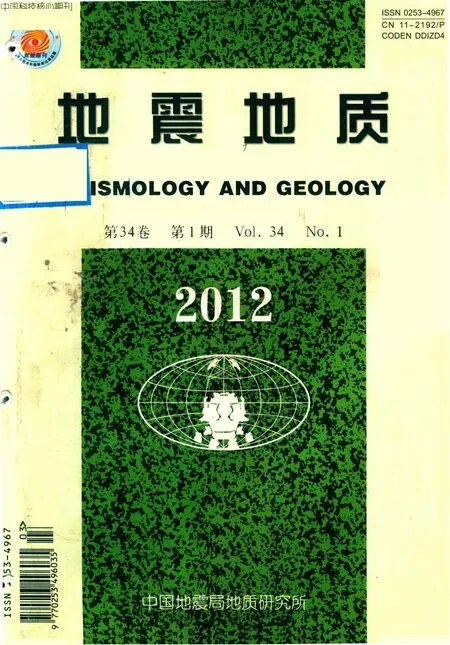断层脆塑性转化带的强度与变形机制及其流体和应变速率的影响
张媛媛 周永胜
(地震动力学国家重点实验室,中国地震局地质研究所,北京 100029)
断层脆塑性转化带的强度与变形机制及其流体和应变速率的影响
张媛媛 周永胜
(地震动力学国家重点实验室,中国地震局地质研究所,北京 100029)
野外、实验和地震数据表明:浅部地壳的变形以脆性破裂为主,深部地壳的变形以晶体塑性流动为主。在这种认识的基础上,提出了地壳变形的2种机制模型,即发生脆性变形的上部地壳强度基于Byerlee摩擦定律以及发生塑性变形的下部地壳强度基于幂次蠕变定律。而位于其间的脆塑性转化带的深度与浅源地震深度的下限具有很好的一致性。然而,二元结构的流变模型局限性在于其力学模型过于简单,往往过高估计了脆塑性转化带的强度。问题的根源在于对脆塑性转化带的变形机制的研究已有很多,但没有定量的力学方程来描述脆塑性转化带强度;而且以往对断层脆塑性转化带的研究主要集中在温度引起的脆塑性转化方面,对因应变速率和流体对脆塑性转化的影响方面的研究也比较薄弱。对断层带内矿物变形机制研究表明,某些断层带脆塑性转化发生在相同深度(温度和压力)内,发生脆塑性转化的原因是应变速率的变化,而这种变化被认为与地震周期的同震、震后-间震期蠕变有关,这种变化得到了主震-余震深度分布变化的证实。对断层流体特征分析表明,断层带内可能存在高压流体,这种高压流体会随断裂带的破裂及愈合而周期性变化,在地震孕育及循环中起着关键性作用。高压流体的形成(裂隙愈合)有多种机理,其中,压溶是断层带裂隙愈合的主导机制之一。研究在水作用下的压溶,可以对传统的摩擦-流变二元地壳强度结构及其断层强度进行补充与修正。通过以上分析,认为有必要通过野外变形样品和高温高压实验,深入研究应变速率及流体压力对断层脆塑性转化的影响,同时,通过实验建立压溶蠕变的方程,近似地估计脆塑性转化带的强度。
脆塑性转化 强度 变形机制 流体 应变速率 压溶
0 引言
断层脆塑性转化带及其对地震深度分布的影响已经得到广泛认同(Chen et al.,1983;Smith et al.,1984;Wong et al.,1990;Bokelmann et al.,2000;周永胜等,2002,2003,2009),但对于脆塑性转化带的强度、变形机制深度及其影响因素,仍然存在很多悬而未决的问题。例如,脆塑性转化带强度都是通过断层摩擦强度与以位错蠕变为基础的流变强度确定,而脆塑性转化深度主要受地壳温度控制,然而,对断层岩研究发现,断层带脆塑性转化带的变形机制至少包括微破裂、位错蠕变、扩散蠕变(包括压溶、颗粒边界迁移、晶体内部扩散)等多种变形机制,脆塑性转化的深度除了与温度相关外,还有流体、应变速率等的影响(Martina et al.,1999;Trepmann et al.,2007;周永胜等,2009)。针对这些问题,本文展开了相关讨论,重点对断层脆塑性转化带的强度与变形机制进行了概述,给出了断层带流体对脆塑性转化带的影响,通过强震与余震深度分布规律的变化,讨论了同震、震后-间震期的应变速率变化对断层脆塑性转化带深度的控制作用。
1 大陆岩石圈强度与地震分布
1.1 大陆岩石圈的强度剖面
自从1914年岩石圈的概念被引入(Barrel,1914)开始,人们对岩石圈的研究不断深入,甚至基于不同的物理化学性质对其进行不同的定义,如力学岩石圈(Schubert et al.,2001)、热岩石圈(White,1988;Rudnick et al.,1988)、地震学岩石圈(Anderson,1995)、弹性岩石圈(White,1999;Watts,2001)、化学岩石圈(Cooper et al.,2004;Lee etal.,2005)、岩石学岩石圈(Griffin et al.,1999;O'Reilly et al.,2001;Poudjom etal.,2001)、电性岩石圈(Wei etal.,2003)等。然而,最初岩石圈的定义是Barrel(1914)从力学强度的角度给出的,认为岩石圈是具有高强度(高黏滞度,低流变性)的地球外壳;另一方面,研究岩石圈强度的变化可以了解地块的强度、地震活动性以及大陆形变和演化的重要机制(郑勇等,2009)。因此,人们迫切需要某种方法来定量估计岩石圈的强度。直到20世纪70年代末,提出了强度包络线的概念(Goetze et al.,1979;Brace et al.,1980),才使人们能够基于实验室获得的本构方程来实现这一愿望(Kohlstedt et al.,1995)。此后,逐渐认识到大陆岩石圈整体的流变结构不同于海洋岩石圈,而且其各介质层之间因受控于不同的流变机制而流变性质也强弱不一(魏荣强等,2007)。
在基于实验资料对岩石圈力学强度的估算中,地壳较浅处断层强度遵从Byerlee(1978)摩擦律

式(1)中τ为断层面上的抗剪强度,μ为摩擦系数,σn为正应力,p为孔隙压力。
对于深部地壳和地幔,由于温度较高,变形以幂律蠕变(Kirby et al.,1987)为主,差应力为


图1 岩石圈强度σ随深度H变化示意图Fig.1 Schematic illustration of the variation of mechanical strengthσas a function of depth H in lithosphere(after Shi et al.,2003).
从图1中可以看出,地温梯度明显影响岩石圈强度,除此之外,地壳分层、物质组成及其流变参数和变形机制也与其密切相关(周永胜等,2003)。总之,在不同的构造环境下,地壳流变性质差别很大(Ranalli,1987;Meissner,1996)。其中,基于高温高压岩石力学实验来研究地壳流变性质最直接、最有效的方法即取得地壳各层岩石流变参数和变形机制(周永胜等,2003)。
1.2 地震深度分布特征
地震是新构造运动的一种形式,震源深度分布是研究孕震环境、深部构造以及地震成因的重要基础(张国民等,2002)。中国是大陆地震最广泛的国家,随着1970年以来地震台网的建立和完善,积累了丰富的地震资料,并且大量地震都有震源深度记录。根据这些资料,汪素云(1996)研究得出了1970年以来 ML≥3.0的 1类精度(震中误差≤5km)地震深度分布统计图(图2)。约91%的地震发生在1~30km内,处于峰值深度段5~25km内的地震约占75.1%。张国民等(2002)也将1970年1月至2000年5月期间所积累的地震定位资料进行筛选分析,给出了中国大陆地震震源深度分布基本上都集中在中上地壳之中。
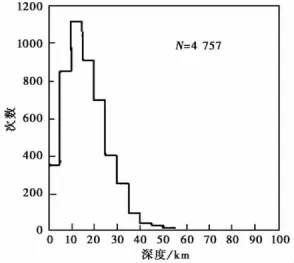
图2 1类精度地震深度统计图(汪素云,1996)Fig.2 Seismic depth statisticalmap with the first class precision(after WANG Su-yun,1996).
Mori等(1997)分别使用1983—1994年和1978—1994年的美国南北加利福尼亚洲的地震目录,研究得出震级在M2.0~5.5范围的地震事件的频率-震级曲线呈线性分布,同时这种频率-震级的线性分布强烈依赖于深度变化(图3)。震级较小(M2~3)时,地震事件主要集中在3~9km的深度内,深度越大,事件越少;随着震级逐渐增大,地震事件也逐渐趋向于分布在更深的深度范围内。然而,纵观所有震级范围的地震事件,其基本上都分布在上地壳中。
对比以上中国和美国加利福尼亚的地震深度数据表明,后者的地震深度整体较浅,而前者的某些地区其地震在中上地壳的各个深度皆有分布。
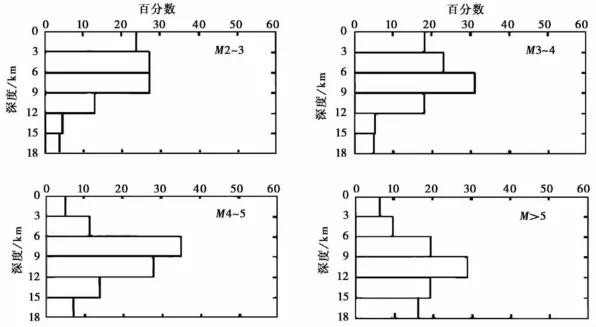
图3 加利福尼亚不同震级地震事件的深度分布Fig.3 Depth distribution of California earthquake for severalmagnitude ranges.
众多研究表明,大陆地震震源深度大多分布在上地壳中(Engdahl et al.,1998;Mori,1991;Melbourne et al.,1997)。关于形成这种现象的物理解释,多数人将其归结为壳内岩石力学性质的变化。
2 地壳岩石变形机制
在应力作用下,岩石会发生位移或变形(付保国等,2003)。探讨岩石的变形机制,主要是借助岩石力学实验结果并结合对比典型天然变形岩石的观察研究,以及与冶金学、材料力学中所获经验的对比(胡玲等,1998)。在显微镜尺度上,岩石的变形机制主要分为脆性和塑性两种变形(Vernon,2004),以及介于二者之间的脆塑性转化。
脆性变形,从宏观角度看,即为脆性破裂或断层摩擦滑动。脆性破裂在地震学辞典(徐世芳等,2000)中这样定义:岩石破裂前没有或很少发生永久变形,1960年格里格斯规定永久变形不超过1%,而赫德规定不超过3%;从微观角度看,脆性变形主要是显微破裂的产生和扩展及有关的碎裂作用;从应力应变角度看,脆性变形表现为岩石或矿物在应力的作用下,超过强度极限时就会发生破裂,使能量突然释放(胡玲等,1998)。总之,在脆性变形中,破裂会在颗粒间或穿过颗粒而发生,并且最终的碎块会发生相对位移(Vernon,2004)。
塑性变形机制比脆性变形机制要复杂得多。岩石塑性变形绝大多数是由单个晶粒的晶内滑动或晶粒间的相对运动(晶粒边界滑动)所造成的,根据变形特征与变形温度、压力条件,一般有位错蠕变和扩散蠕变两种主要机制。其中,位错蠕变包括位错滑移、位错攀移、动态重结晶等,而扩散蠕变包括压溶、颗粒边界迁移(Coble蠕变)、晶体内部扩散(Nabarro-herring蠕变)等。每一个具体的变形机制都有其对应的变形条件、过程及最终形成的显微构造特征,图4所示为典型的变形机制图。位错滑移、位错攀移(或动态重结晶)及扩散蠕变(压溶、Coble蠕变及N-H蠕变)分别位于不同的温度-应力区域。但在相同应变速率下,位错滑移发生在较高应力、较低温度下,一般应力指数n>5,会产生很强但不连续的波状消光,没有重结晶和亚颗粒,在透射电镜中显示有高密度不规则的缠结位错;而位错攀移及动态重结晶相对而言发生在较低应力、较高温度下,一般应力指数2≤n≤5,会产生连续的波状消光,亚颗粒和动态重结晶颗粒,透射电镜中显示有不规则的网状位错。对于扩散蠕变而言,只出现在细粒集合体中,在电镜中没有内部应变组构和晶体优选方位,一般应力指数n<2,其中,Coble蠕变发生在较低温度下,N-H蠕变发生在较高温度下。值得特别说明的是,压溶蠕变是指岩石在差应力作用下,可溶性物质在高应力处溶解、低应力处沉淀的过程,是一种由于液相存在而蠕变机制大大提高的低温扩散蠕变机制。如图5所示,压溶作用分为3个阶段(Weyl,1959;Renard et al.,1997):1)在有效应力驱动下,可溶性物质溶解,并且在颗粒相接触的边界相交叉;2)在化学能和流体通量的促使下,可溶性矿物从高应力处扩散;3)可溶性物质在低应力处沉淀。这是一个依赖于时间的非常缓慢的物质扩散迁移过程,且3个阶段中最慢的速率将控制整个压溶蠕变过程的速率(Rutter,1983;Gratier etal.,2009)。如果这个过程相对于地震循环周期来说足够快,它们将能够改变断层的蠕变特性(Renard et al.,2000)。总之,在塑性变形中,颗粒会改变其形状或相对彼此移动而不发生破裂(Vernon,2004)。

图4 典型的岩石变形机制图Fig.4 The typical deformationmap of rocks.
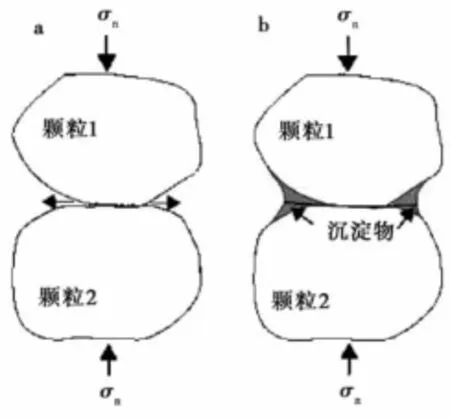
图5 压溶的概念模型Fig.5 A conceptual pressure-solutionmodel.
3 地壳脆塑性转化带特征
3.1 脆塑性转化的定义
断层带内变形岩石的野外观察表明,从纯脆性到纯塑性变形的转化过程会发生在相对很大的温压范围内(Sibson,1977)。后来依据长石和石英的流变性(Scholz,1990)、应用岩盐的模拟实验研究(Shimamoto,1989)、断层构造岩的主要变形机制(何永年,1989)及依据变形变质作用环境(刘喜山等,1992)开展的研究都取得了类似的认识。在这个过程中,破裂模式的变化伴随着破裂机制的变化。Kohlstedt等(1995)按照Rutter(1986)的术语,认为破裂模式的转化为脆延性转化(BDT),主导机制的转化为脆塑性转化(BPT)(图6)。不过,有人认为脆延性转化更多的指脆塑性转换,即脆性(破裂、碎裂或摩擦)向晶体塑性变形的转化 (Rutter,1986;Chester,1988;Shimamoto,1989)。但更多的人强调这是两个不同的概念,脆延性转化(BDT)特指岩石从宏观局部变形到宏观均匀变形的转化,这种转化与力学行为相关;脆塑性转化(BPT)指岩石从微观脆性变形到微观塑性变形的转化,这种转化不仅与力学行为相关,而且与微观机制相关(Carter et al.,1987;Evans etal.,1990;Hirth etal.,1994)。表1所示为脆塑性转化与脆延性转化在各种力学特性和微观构造等方面的具体差异。从表中可以看出脆性向半脆性转化的特征为局部化破裂和应力降消失,出现碎裂和塑性变形,强度主要受围压影响,但对温度和应变速率不敏感;半脆性向晶体塑性转化的标志特征为碎裂、扩容和声发射消失,出现大量晶体塑性变形,并且强度对围压不敏感而对温度和应变速率敏感。
3.2 脆塑性转化带对应的深度
从上述以摩擦和流变实验为基础得到的岩石圈强度剖面可以看出,随着深度的增加,岩石从脆性破裂、摩擦向塑性流动转化。脆塑性转化一方面控制了岩石圈的应力极限(强度峰值)(Brace et al.,1980;Kirby,1980;Meissner et al.,1982;Smith et al.,1984;Meissner,1996);另一方面对浅源强震的发震深度、机制和过程具有重要意义(Sibson,1982;Chen etal.,1983;Smith etal.,1984;Wong etal.,1990;Bokelmann etal.,2000;周永胜等,2002,2003)。

表1 脆塑性转化与脆延性转化的具体定义(Evans et al.,1990)Table 1 The specific definition of brittle-ductile transition(BDT)and brittle-plastic transition(BPT)(after Evans et al.,1990)
Sibson(1982)通过对美国不同热流值区域内的陆壳地震深度分布研究,发现微地震的截止深度强烈依赖于地热等温线,并且地震层-无震层的转化能够合理地通过长英质岩石地壳的摩擦-似塑性层的转化来模拟。随后,越来越多的研究发现,摩擦和塑性流变的转化深度控制了余震发生的深度下限,也就是说,脆塑性转化的深度与浅源地震深度的下限具有很好的一致性(Chen et al.,1983;Smith et al.,1984;Wong et al.,1990;Bokelmann et al.,2000;周永胜等,2002,2003;宋娟等,2008)。之所以会有这样的基本特征,多数人将其归结为壳内岩石力学性质的变化。即上部地壳是基于Byerlee摩擦律的脆性层,易于积累弹性应变能,大陆强震主要发生在此区域内;下部地壳是基于幂次蠕变律的塑性层,难以积累应变能,一般形成无震层;而在其之间的深度附近,存在一个由脆性地壳逐渐转化为塑性地壳的脆塑性转化带,余震可以发生在此区域内。这是因为,地震成核主要受摩擦稳定性控制,只有当速度弱化,断层滑动才能成核,从而形成潜在的震源区(Tse et al.,1986;何昌荣等,1988;He,2000,2003;He et al.,1998 ,2003)。与强震不同,存在微弱的速度弱化或微弱的速度强化均有可能产生触发型不稳定滑动(Gu et al.,1991;Boatwright et al.,1996;He et al.,1998,2003;He,2000,2003),从而产生余震。
因此,岩石圈脆塑性转化带的研究对于认识大陆地震深度分布特征及其成因有着重要意义。
3.3 脆塑性转化带的强度
基于Byerlee摩擦准则和稳态蠕变准则得到的地壳强度的深度剖面模型最主要特征是:存在一个明显的脆塑性转化带,它仅仅是两种准则外推的一个虚构结果(Ohnaka,1995)。研究表明,这种直接外推的做法往往过高估计了半脆性域的应力极限(或强度峰值)(Kirby,1980;Carter et al.,1987)。
目前,尽管脆塑性转化带处岩石的破裂准则未知,无法得到基于详细微观力学行为的本构方程,但关于其强度的研究已有很多。Kirby(1980)通过假定脆塑性转化发生在有效围压等于摩擦强度的0.4倍,进而估计了半脆性流动发生的初始压力。Chester(1988)提出了半脆性变形的总强度能够表达为蠕变强度σc和破裂强度σf的函数

式中的φ是一个由tanh(βσ3)给出的综合参数,其中β是一个物质常数。尽管这个等式提供了脆塑性变形强度的定量估计,但它假设脆塑性转化是一个独立过程,并且没有考虑到温度的影响。很多学者在没有详细信息的情况下,一般估计半脆性变形开始是通过假设部分塑性流动发生了,即当屈服强度或流动强度不到摩擦强度的5倍时。这个估计准则假设沿着断层的应力集中会使局部应力足够大而导致屈服。尽管这个估计未能很清楚地定量说明,至少它提供了转化带处压力的速率和温度依赖性。但是目前所有的这些估计在一些方面仍然是不足的,比如它们都没有基于一个详细的物理模型,并且它们也不能够解释应变速率、颗粒大小、孔隙度、二相性、水逸度以及温度的影响(Kohlstedt,1995)。Ohnaka(1995)通过对前人所做的关于脆塑性转化带处Westerly花岗岩的实验数据分析,得到在应变速率为时,脆性到脆塑性转化带的强度法则为

从以上函数可以看出,作者在其中引入了应变速率的影响,但此函数对于脆塑性转化带处的定量影响是不知道的,仅仅已知的是,应变速率对脆塑性转化带处强度的影响要比脆性变形机制的明显,但却不及它对塑性变形机制的影响大。
总体而言,脆塑性转化带处的强度目前还没有一个定量认识,这可能有多方面原因,如对岩石脆塑性转化缺乏足够的认识,没有建立起一系列能够把实验结果和野外研究统一起来的变形机制图等(周永胜等,2000)。
3.4 脆塑性转化带处岩石的变形机制
地壳岩石的脆塑性转化比较复杂,与温度、压力、应变速率、岩性、粒度、孔隙度、水等多种因素相关(Evans et al.,1990)。例如高孔隙的石英岩(Hirth et al.,1989)、砂岩(Wong,1990,1997)、玄武岩(Shimada,1986)、含蛇纹石的橄榄岩和辉长岩(Byerlee,1986)等主要表现为脆性破裂向碎裂流动的转化,而低孔隙结晶岩的脆塑性转化包括局部脆性破裂、半脆性(包括碎裂流动、半脆性破裂与流动)、半塑性流动、塑性流动等几个阶段(Chester,1988;Shimamoto,1989;Evans et al.,1990;Tullis et al.,1992;Hirth et al.,1994)。
周永胜等(2000)对前人的研究工作进行总结,将主要造岩矿物的脆塑性转化特征大体分为2种类型:1)以脆塑性过渡域出现明显的碎裂流动为特征,并且塑性变形以机械双晶、重结晶为主,如长石(Tullis et al.,1987,1992;Hadizadeh,1992)、方解石(Fredrich et al.,1989)、岩盐(Chester,1988)、角闪石(Hacker et al.,1990)等;2)脆塑性过渡域不出现明显的碎裂流动,而出现半脆性破裂和半脆性流动,没有或含少量机械双晶,塑性变形以位错滑移为主,如石英(Hirth et al.,1994)、辉石(Kirby etal.,1984;Boland etal.,1986)等。研究发现:由单相矿物组成的岩石脆塑性转化与其组成矿物特征类似,而对于多相矿物组成的岩石其脆塑性转化比较复杂。
地壳成分分析表明,对脆塑性转化带处岩石变形机制起制约作用的主要矿物为石英(或石英-长石组合)。有关石英脆塑性转化的研究,最具有代表性的工作是Hirth等(1994)的实验结果和Stipp等(2002)的野外结果。图7所示为Hirth等(1994)的实验结果,可以看出,随着温度和压力的升高,石英变形机制经历脆性破裂、半脆性(包括碎裂流动、半脆性破裂与流动)、塑性变形3个阶段。
周永胜等(2000)在前人研究的基础上,对石英和长石脆塑性转化的变形特征及实验室与自然界环境下的温压条件进行了比较。对比发现,石英和长石的变形特征不同:石英向塑性转化的温压条件比长石低,表明石英易产生塑性变形;石英稳态蠕变的机制为位错滑移、位错攀移和重结晶,长石主要表现为重结晶;石英很少出现扩散蠕变,长石在高温下可以有扩散蠕变。
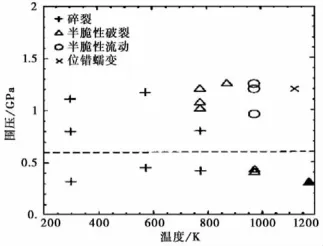
图7 石英的脆塑性转化与温压关系Fig.7 The brittle-plastic transition of quartz at different T-P conditions.
周永胜等(2002)也研究了花岗岩的脆塑性转化,如图8所示:在300~800℃范围内,存在脆塑性转化域,且在该域内,随着温度增加,由半脆性破裂向碎裂流动和半脆性流动过渡,其转化温度随围压增加而增加。

图8 花岗岩的脆塑性转化与温压关系(周永胜等,2002)Fig.8 The brittle-plastic transition of granite at different T-P conditions(after Zhou et al.,2002).
尽管目前对地壳岩石的脆塑性转化机制进行了多方面的研究工作,但流体相对于岩石脆塑性转化的意义还有待进一步研究。
4 流体作用
4.1 断层深部流体
地壳流体是地球的主要组成物质之一。前苏联的科拉超深钻(科兹洛夫斯基,1988),德国的KTB科学钻(李有源,1996),构造地质学家们发现铲状构造,地球物理学家们发现地壳中存在高导、低速、减密、高热的物性异常层(车用太等,2000)以及越来越多的流体作用及其机理的实验和观测结果(易立新等,2003;Zhang et al.,2004;Kodaira et al.,2004)都证实了地壳中流体存在的普遍性与重要性。
事实上,地壳中的流体主要活动在断裂带中(车用太等,2000),这一论点能够被多种数据证明:地球物理学数据(如大地电磁的野外研究),地球化学数据(如稳定同位素及追踪元素分析),地质学数据(愈合裂隙中流体侵入矿物的研究)等(Gratier et al.,2002)。对断裂带中流体活动的大量研究表明,一方面,断层带,特别是地震活动规模较大的断层带内具有超压流体,并且在断层力学过程和化学过程中发挥了重要作用(Sibson,1981;Parry et al.,1986;Rice,1992;Cox,1995);另一方面,流体压力会随着断层带的破裂或愈合而变化(Gratier et al.,2002;Trepmann et al.,2003)。然而,目前对断层带中流体超压机制存在多种假说,如流体室模式(Byerlee,1993),应力障模式(Gudmundsson,1990),连续流动模式(Rice,1992),断层阀门模式(Sibson,1981),流体域模式(Gold et al.,1984,85)等。尽管每一种假说都有一定的事实基础,但没有一种模式能解释所有的现象。因此,众多模式也只是反映了一些主要思想,还存在许许多多不确定因素(刘亮明,2001)。
4.2 流体对断层强度、断层滑动、地震孕育发生的影响
在震源附近,温度、压力很高,岩石密度较大,即使岩石内部存在断裂,岩体之间发生突然错动也是十分困难的。研究发现,断层深部流体将会通过物理的或者化学的作用对岩石的力学性质与流变性质产生显著影响(Spiers et al.,1999;马立杰等,2001),影响着岩石的变形机制、断层作用演化、地震的孕育发生等(Groshong,1988;Newman et al.,1994)。
从物理角度,根据有效应力定律,如果存在非常高的流体压力,流体孔隙压对断层强度有明显的弱化作用。图9所示为在不同流体压力条件下给出的断层摩擦强度与地壳流变结构。水的存在使断层的摩擦强度和脆塑性转化域地壳强度都显著降低,且脆塑性转化带下移(Martina et al.,1999;周永胜等,2009)。

图9 流体对岩石强度的影响(Martina et al.,1999)Fig.9 Fluid impact on the strength of rock(after Martina et al.,1999)
从化学角度看,在一定温度、压力条件下,水对岩石溶解或物质在岩石表面沉积具有一定作用(车用太等,2000),即水岩作用。正是由于这种水岩作用,断裂带既可作为流体的通道,又可作为阻碍流体运动的障碍(Sibson,1981;Hippler,1993)。由于水岩相互作用,不断有固体物质沉积在断裂带两侧岩壁上,久而久之断裂带逐渐被沉积物充填,直至某些部位被填死,与此同时流体活动不断被减弱,直至被封闭在断裂带内。此后,当区域构造应力逐渐加强时,断裂带内封存有流体的段内,同时产生剪应力增强与抗剪强度减弱的过程,结果比无封存段更容易达到破裂状态,而每一次破裂则相当于一次地震发生。当地震发生后,断裂带被贯通,其中的流体再次活跃起来,并重复上述过程,直至再一次地震发生(车用太等,2000)。同时,水岩作用还会产生大量低摩擦系数的矿物,如橄榄石变成蛇纹石与滑石;辉石变成角闪石、绿泥石、阳起石等;长石变成石英+云母+角闪石+绿帘石等,断层会被弱化,其摩擦强度大幅度降低(Wintsch et al.,2002;周永胜等,2009)。其中,水解弱化作用是影响矿物或岩石力学与流变学状态的重要化学过程(刘俊来等,2001),如很多学者开展了微量水对石英(Jaoul et al.,1984;Hobbs,1985;Koch et al.,1989;Post et al.,1998)、长石(Tullis et al.,1996;Rybacki et al.,2000)、花岗岩(Tullis et al.,1980)、方解石质岩石(刘俊来等,2001)、长石-辉石组合(Dimanov et al.,2005)等的水解弱化作用的研究。水解弱化作用,不仅体现在随着水含量增加,样品蠕变速率增加,而流变强度、激活能减小,而且在变形机制图中发生扩散蠕变所需的温度、应力和矿物粒度范围扩大,发生位错蠕变所需的温度、应力和矿物粒度范围缩小。这表明晶体内部微量水不仅促进了矿物的位错攀移和恢复作用,而且加速了晶体边界迁移与扩散(Rybacki et al.,2004;周永胜等,2008)。
流体压力对断层机制影响的研究已有很多(Lachenbruch,1980;Sleep et al.,1994;Chester,1995;Matthai et al.,1996;Lockner et al.,1995;Fournier,1996;Miller et al.,1996;Yamashita,1997;Henderson et al.,1997),Byerlee(1993)和Rice(1992)先后提出某些断层的弱化是由于内部高压流体的存在,这种高压能够通过深部流体流入断层塑性层的底部,并通过愈合断层裂隙及压实断层泥而产生维持,地震则发生在该流体压力高达静岩压力时;另一方面,地震后由于断层连通性及岩石渗透率显著增长,流体压力接近静水压,而上述过程重复发生。如图10所示,断层带内流体压力如此周期性的变化过程与地震的形成机理有关,这一观点已被越来越多的研究证明(Renard et al.,2000;Gratier et al.,2002;Tenthorey et al.,2003;Trepmann etal.,2003)。因此,有必要对高压流体(裂隙愈合)的形成机理进行详细研究。
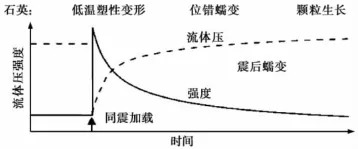
图10 地震前后断层流体含量及强度随时间的变化(Trepmann et al.,2003)Fig.10 Conceptual scheme visualizing the inferred history of stress and pore fluid pressure during synseismic loading and postseismic creep in the uppermost Plastosphere(after Trepmann et al.,2003).
Gratier等(2002)通过对加利福尼亚活断层的研究表明,裂隙愈合的方式主要有3种(图11)。第1种为在矿物表面能驱动下的裂隙自愈合方式(图11a),但此愈合方式仅仅局限于几μm宽的小裂隙中。一般而言,断层带内大多数裂隙的愈合都伴随着矿物的溶解-沉淀。第2种为在应力驱动下的溶解-沉淀机制,即压溶蠕变机制(图11b),此机制下形成的封闭系统从几mm到几百m不等。第3种机制是在断层浅部,流体随着其高压消失而向上排出,原先溶解于高压流体中的矿物质(岩盐、方解石、石英等)在裂隙中析出结晶,形成脉体,愈合了断层带中的裂隙(Whitmeyer et al.,2005;Xu et al.,2008)(图11c)。研究表明,压溶是断层带内裂隙愈合的主要机制,同时,断层泥的压实过程也是压溶作用的结果,这是压溶作用的2种模型,即颗粒间的压溶及2个碎裂岩块间的压溶。如图12所示,压溶作为裂隙愈合的主导机制时所在断层的位置、模型及野外的显微构造图。事实上,一次地震后,流体压降为近静水压,岩石渗透率全面增长,水岩作用的第1个阶段则以发生在自由表面的快速裂隙自愈合机制(图11a)及一些变质反应为主,但断裂带裂隙愈合的主导过程则是2种模型下的压溶机制(图12)。

图11 裂隙愈合的各种机制Fig.11 Variousmechanisms of cracks sealing.

图12 断层泥内颗粒间的压实和断裂带附近的碎裂愈合Fig.12 Grain compaction in gouge and crack sealing around faults.
越来越多的研究表明,压溶是间震期裂隙愈合和断层泥压实的一种主导机制(Gratier et al.,1994;Evans etal.,1995;Renard et al.,2000;Bos etal.,2002a,b;Frye et al.,2002;Gratier etal.,2002;Yasuhara et al.,2005)。在野外,对压溶机制的观察和地质解释已有很多(Rutter,1983;Rybacki etal.,2011;Nenna etal.,2011),其中,缝合线是其典型构造。同时,已有很多学者在实验室的条件下对岩石或断层泥的压溶机制进行了研究(Rutter,1983;Tenthorey et al.,2003;Yasuhara,2005;Anzalone et al.,2006),矿物边界会形成锯齿状的典型特征。还有许多学者在给定压溶的2种模型的基础上,通过数值模拟的方法来确定不同因素,如温度、应力、颗粒大小、应变速率等对压溶机制的影响(Renard et al.,2000;Gratier et al.,2002)以及来解释压溶构造的形成及其之间的关系(Nenna et al.,2011)。但目前为止,定量研究水对压溶的影响及如何通过实验建立适合描述压溶为主导机制的断层强度的本构方程的研究却很少。
此外,实验室和野外观察表明,水作用下的压溶蠕变补充了传统的摩擦-流变地壳强度结构(Winston et al.,2002)。然而,尽管已有很多学者对石英及方解石的压溶作用进行过研究(Renard et al.,2000;刘俊来等,2000;Yasuhara etal.,2005;Zhang etal.,2010),但在脆塑性转化带的温压范围内的研究却很少。因此,有必要探讨流体对脆塑性转化带处岩石的强度及变形机制的影响,特别是有关压溶机制的考虑。
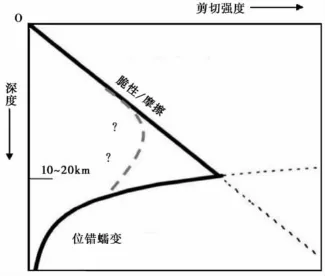
图13 通过Byerlee摩擦定律及位错蠕变方程得到的地壳强度轮廓图(实线)Fig.13 Schematic diagram showing the crustal strength profile defined by relations describing brittle/frictional behavior(Byerlee's law)and dislocation creep(solid lines).
5 讨论
(1)压溶作用对脆塑性转化强度的影响。如图13,通过脆塑性转化变形机制的研究得出,研究者更多的是关注脆性变形和以位错蠕变为主的塑性变形的研究,而地壳和断层带中,压溶作用是脆塑性转化带的另一种主要变形机制。因此,当考虑压溶作用作为断层的主导机制时,脆塑性转化带的强度将如何变化?对比脆性破裂的强度准则、稳态流变方程、脆塑性转化带的经验关系式,其强度普遍大于压溶方程给出的强度。如果在脆塑性转化带压溶作用普遍存在,那么其变形机制对脆塑性转化带的强度具有显著影响和控制作用。我们试图通过实验室的压溶蠕变实验,建立初级的压溶蠕变方程,近似地估计和修正脆塑性转化带的强度。
选择如图12b所示的颗粒间压溶作用对断层脆塑性转化强度影响的模型,根据Spiers等(内部交流)对此模型进行理论计算得到的下述压溶蠕变方程

其中,Ad是一个依赖于颗粒形状的参数,其大小在4~100之间;Z=DCS,其中D是溶解物的扩散系数,C是溶体的浓度,S是原子的表面体积;Ω是原子体积;d是颗粒大小;K是一常数;T是温度;σ是应力;是应变速率。为了在实验室方便的应用,上述公式可以简化为

(2)应变速率和流体压力对脆塑性转化的影响。通常,控制断层脆塑性转化的主要因素是温度,如图9所示,其他条件一经确定,温度控制了脆塑性转化带的深度。但最近有研究显示(Renard et al.,2000;Trepmann et al.,2001,2002,2003,2007;Gratier et al.,2002;Schaff et al.,2002;Tenthorey et al.,2003;Zhou et al.,2004;Frost et al.,2011),应变速率和流体压力同样对断层的脆塑性转化有显著的控制作用。Schaff等(2002)通过对发生在圣安德列斯断层系中一条分支断层上的地震震源深度进行精确定位,发现一次大震后一段时间内余震的震源深度变深,然后随着时间而逐渐变浅(图14)。周永胜等(2004)对丽江1996年MS7.1地震及其余震序列的震源深度进行统计分析,也得到同样规律(图15)。震源深度这种分布规律,被认为是应变速率对断层脆塑性转化影响的证据。如图16所示,一次大地震爆发之后的一段时间(early postseismic),由于断层的滑动速率依旧很大,致使断层带内的岩石仍然处于很高的应变速率,而高应变速率又导致了断层的脆塑性转化带下移,但随着时间的延续,断层滑动速率逐渐减小,应变速率逐渐恢复,而脆塑性转化带也逐渐恢复到原来的深度。也就是说,应变速率影响了脆塑性转化带的深度,进而影响了余震深度的分布。各种数据表明,断层带内存在高压流体,并且流体压力的大小也在一定程度上控制着断层的脆塑性转化(Renard et al.,2000;Trepmann et al.,2001,2002,2003,2007;Gratier et al., 2002;Tenthorey et al.,2003),如图9所示,断层脆塑性转化带的深度会随流体压力的增长而下移。同时,研究表明,断层带内的高压流体会随断裂带的破裂及愈合而周期性的变化,与地震的孕育及循环机理有关(Renard et al., 2000;Gratier et al., 2002;Tenthorey et al.,2003;Trepmann et al.,2003)。因此,基于应变速率和流体压力对断层脆塑性转化的影响对探讨地震的形成具有实际意义,有必要通过野外样品分析和高温高压实验做深入的研究。
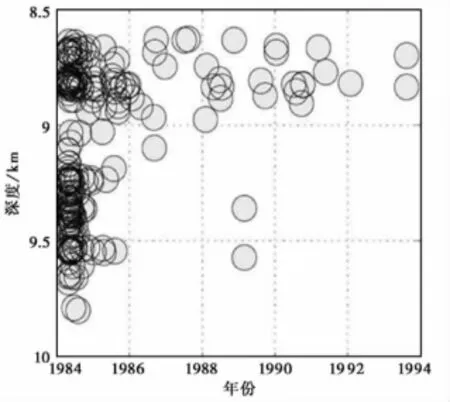
图14 震源深度分布图(Schaff et al.,2002)Fig.14 The sketch of focal depth distribution(after Schaff et al.,2002).

图15 主震及其余震深度分布图Fig.15 The sketch of depth distribution ofmain shock and a series of aftershocks.
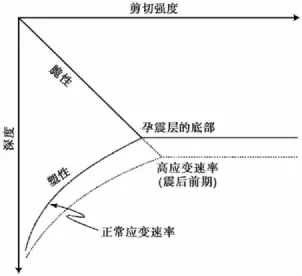
图16 一次地震后由于高应变速率而导致脆塑性转化带下移(Schaff et al.,2002)Fig.16 Cartoon depicting change of brittle-plastic transition due to higher strain rates right after themain shock(after Schaff et al.,2002).
断层脆塑性转化深度的变化会影响地震成核深度。对大陆浅源强震发震深度的控制因素有不同的认识:1)与断层从黏滑向稳滑过渡的深度有关(Tse et al.,1986);2)与脆塑性转化深度有关(Sibson,1982;Li et al.,1987;Scholz,1988),它不仅受石英脆塑性转化制约,而且与长石脆塑性转化有关(Gleason et al.,1995);3)与由非稳定塑性流动向稳定塑性流动转变的临界温度有关(Hobbs,1986)。但最近Aki等人(2004)通过确定区域介质品质因子Q的方法得到脆塑性转化带中的塑性破裂(ductile fractures)在地震的加载过程中起着关键性的作用,这种认识不同于传统观点,还需进一步研究。
致谢 两位审稿专家对本文提出了很好的建议,在此表示感谢!
车用太,鱼金子,王基华,等.2000.地壳流体与地震活动关系及其对地震预测探索的启示[J].地震,20(增):91—96.
CHE Yong-tai,YU Jin-zi,WANG Ji-hua,et al.2000.The relation between fluid in crust and seismic activity and its enlightenment to earthquake prediction [J].Earthquake,20(suppl):91—96(in Chinese).
付保国,候青亚.2003.岩石变形显微构造形成机制及矿物中常见的变形显微构造特征[J].甘肃冶金,25(3):1—4.
FU Bao-guo,HOU Qing-ya.2003.The formationmechanism of rock and common microstructure feature in minerals[J].Gansu Metallurgy,25(3):1—4(in Chinese).
何昌荣,马胜利,黄建国.1988.断层滑动速率变化对滑动稳定性的影响[J].地震地质,20(1):54—62.
HE Chang-rong,MA Sheng-li,HUANG Jiang-guo.1988.Influence of loading rate variation on the stability of faultmotion[J].Seismology and Geology,20(1):54—62(in Chinese).
何永年.1989.断层带岩石变形机制探讨[A].见:国家地震局地质研究所编.现代地壳运动(4).北京:地震出版社.
HE Yong-nian.1989.The investigation into themechanisms of fault rocks[A].In:Institute of Gology,SSB(ed).Modern Crustal Movement(4).Seismological Press,Beijing(in Chinese).
胡玲编著.1998.显微构造地质学概论[M].北京:地质出版社.
HU Ling.1988.Introduction to Microstructural Geology[M].Geological Publishing House,Beijing(in Chinese).
李有源.1996.欧洲共同体国家地壳流体研究的某些进展与发展趋势[J].地学前缘,3(4):313—323.
LIYou-yuan.1996.Some progress and the development trend of the crustal fluid research about the European Community countries[J].Earth Science Frontiers,3(4):313—323(in Chinese).
刘俊来,刘正宏,徐仲元,等.2000.上部地壳岩石变形与方解石质岩石的低温流动[J].世界地质,3:209—216.
LIU Jun-lai,LIU Zheng-hong,XU Zhong-yuan,et al.2000.The deformation of rocks in the upper crustal level and the mechanisms of low temperature flow of calcite rocks[J].World Geology,3:209—216(in Chinese).
刘俊来,马立杰,崔迎春,等.2001.上地壳环境中的流体作用与灰岩的脆-韧性转变[J].地学前缘,8(3):171—176.
LIU Jun-lai,MA Li-jie,CUI Ying-chun,et al.2001.Fluid flow and brittle to ductile transition of limestone under the upper crustal conditions[J].Earth Science Frontiers,8(3):171—176(in Chinese).
刘亮明.2001.断层带中超压流体及其在地震和成矿中的作用[J].地球科学进展,16(2):238—243.
LIU Liang-ming.2001.Overpressured fluids in fault zones and their roles in earthquakes and hydrothermalmetallogeny[J].Advance in Earth Sciences,16(2):238—243(in Chinese).
刘喜山,刘树勋,刘俊来.1992.变形变质作用及成矿[M].北京:中国科学技术出版社.
LIU Xi-shan,LIU Shu-xun,LIU Jun-lai.1992.Deformation-metamorphism and Metallogenesis [M].Science and Technology of China Press,Beijing(in Chinese).
马立杰,刘俊来,崔迎春.2001.浅部地壳岩石变形过程中地质流体的化学效应:水解弱化及其微观机制[J].地学前缘,3-4:244.
MA Li-jie,LIU Jun-lai,CUI Ying-chun.2001.The chemistry effects of geological fluid in shallow crustal:Micromechanism and hydrolytic weakening[J].Earth Science Frontiers,3-4:244(in Chinese).
石耀霖,朱守彪.2003.中国大陆震源机制深度变化反映的地壳-地幔流变特征[J].地球物理学报,46(3):359—365.
SHIYao-lin,ZHU Shou-biao.2003.Contrast of rheology in the crustandmantle near Moho revealed by depth variation of earthquakemechanism in continental China[J].Chinese Journal of Geophysics,46(3):359—365.
宋娟,周永胜,何昌荣.2008.石英岩脆塑性转化的实验研究[J].高压物理学报,22(2):167—174.
SONG Juan,ZHOU Yong-sheng,HE Chang-rong.2008.The brittle-plastic transition in experimentally deformed quartzite[J].Chinese Journal of High Pressure Physics,22(2):167—174(in Chinese).
汪素云.1996.中国大陆地震震源分布特征的初步研究[J].地震研究,19(3):310—314.
WANG Su-yun.1996.Preliminary study on distribution characteristics of earthquake sources in the Chinese mainland[J].Journal of Seismological Research,19(3):310—314(in Chinese).
魏荣强,臧绍先.2007.大陆岩石圈流变结构研究进展及存在的问题[J].地球物理学进展,22(2):359—364.
WEIRong-qiang,ZANG Shao-xian.2007.Progresses and problems in the study of the rheological structure of the continental lithosphere[J].Progress in Geophysics,22(2):359—364(in Chinese).
徐世芳,李博主编.2000.地震学辞典[M].北京:地震出版社.46.
XU Shi-fang,LIBo(ed).2000.Seismology Dictionary[M].Seismological Press,Beijing.46(in Chinese).
易立新,车用太,王广才.2003.地壳中流体动力学模型研究[J].地震,23(2):108—114.
YILi-xin,CHE Yong-tai,WANGGuang-cai.2003.A study of fluid dynamicsmodel in the crust[J].Earthquake,23(2):108—114(in Chinese).
张国民,汪素云,李丽,等.2002.中国大陆地震震源深度及其构造含义[J].科学通报,47(9):663—668.
ZHANG Guo-min,WANG Su-yun,LI Li,et al.2002.Focal depth of earthquakes in Chinese mainland and its tectonic implications[J].Chinese Science Bulletin,47(9):663—668(in Chinese).
郑勇,李永东,熊熊.2009.岩石层各向有效弹性厚度的小波相关性分析[A].中国地球物理,335.
ZHENG Yong,LI Yong-dong,XIONG Xiong.2009.Analysis on anistropic effective thickness of lithosphere by wavelet coherencemethod [A].In:Proceedings of the 25th Annual Meeting of Chinese Geophysics Society,Hefei,China.335(in Chinese).
科兹洛夫斯基E.A.1987.克拉超深井[M].张秋生译.北京:地质出版社.189—199.
Kozlovsky E A.1987.The Superdeep Hole of the Kola Peninsula[M].Translated by ZHANG Qiu-sheng.Geology Publishing House,Beijing.189—199(in Chinese).
周永胜,何昌荣.2000.地壳岩石变形行为的转变及其温压条件[J].地震地质,22(2):167—178.
ZHOU Yong-sheng,HE Chang-rong.2000.Deformation behavior transition of crustal rocks and its temperature-pressure condition[J].Seismology and Geology,22(2):167—178(in Chinese).
周永胜,蒋海昆,何昌荣.2002a.不同温压条件下居庸关花岗岩脆塑性转化与失稳型式的实验研究[J].中国地震,18(4):389—400.
ZHOU Yong-sheng,JIANG Hai-kun,HE Chang-rong.2002a.Experiments of brittle-plastic transition,modes of instability of Juyongguan granite at different T-P condition [J].Earthquake Research in China,18(4):389— 400(in Chinese).
周永胜,何昌荣.2002b.华北地区壳内低速层与地壳流变的关系及其对强震孕育的影响[J].地震地质,24(1):124—132.
ZHOU Yong-sheng,HE Chang-rong.2002b.The relationship between low velocity layers and rheology of the crust in North China and its effect on strong earthquake[J].Seismology and Geology,24(1):124—132(in Chinese).
周永胜,何昌荣.2003.地壳主要岩石流变参数及华北地壳流变性质研究[J].地震地质,25(1):109—122.
ZHOU Yong-sheng,HE Chang-rong.2003.Rheological parameter of crustal rocks and crustal rheology of North China[J].Seismology and Geology,25(1):109—122(in Chinese).
周永胜,何昌荣,杨恒.2004.水对下地壳基性岩脆塑性转化影响的实验研究[J].地震地质,26(3):472—483.
ZHOU Yong-sheng,HE Chang-rong,YANG Heng.2004.The effect of water on brittle-plastic transition of lower crustal mafic rocks[J].Seismology and Geology,26(3):472—483(in Chinese).
周永胜,何昌荣,杨晓松.2008.中地壳韧性剪切带中的水与变形机制[J].中国科学(D辑),38(7):819—832.
ZHOU Yong-sheng,HE Chang-rong,YANG Xiao-song.2008.The water and deformationmechanism in ductile shear zone in the earth's crust[J].Science in China(Ser D),38(7):819—832(in Chinese).
周永胜,何昌荣.2009.汶川地震区的流变结构与发震高角度逆断层滑动的力学条件[J].地球物理学报,52(2):474—484.
ZHOU Yong-sheng,HE Chang-rong.2009.The rheological structures of crust and mechanics of high-angle reverse fault slip for Wenchuan MS8.0 earthquake[J].Chinese Journal of Geophysics,52(2):474—484(in Chinese).
Aki K.2004.A new view of earthquake and volcano precursors[J].Earth Planets Space,56:689—713.
Anderson D L.1995.Lithosphere,asthenosphere,and perisphere[J].Rev Geophys,33:125—419.
Anzalone A,Boles J,et al.2006.Confined fluids and their role in pressure solution[J].Chem Geol,230:220—231.
Barrel J.1914.The strength of the Earth's crust.Ⅰ.Geologic tests of the limits of strength [J].JGeol,22:28—48.
Boatwright J,Cocco M.1996.Frictional constraints on crustal faulting[J].JGeophys Res,101:13895—13909.
Bokelmann G H R,Beroza G C.2000.Depth-dependent earthquake focalmechanism orientation-Evidence for a weak zone in the lower crust[J].JGeophys Res,105(B9):21683—21695.
Boland JN,Tullis TE.1986.Deformation behavior ofwetand dry clinopyroxenite in the brittle to ductile transition region[A].In:Hobbs B E and Heard H C,eds,Mineral and rock deformation:Laboratory studies.Geophys Monogr Ser,Vol.36,AGU,Washington,D C.35—50.
Bos B,Spiers C J.2002a.Fluid-assisted healing processes in gouge-bearing faults:Insights from experiments on rock analogue system[J].Pure Appl Geophys,159:2537—2566.
Bos B,Spiers C J.2002b.Frictional-viscous flow of phyllosilicate-bearing fault rock:Microphysicalmodeland implications for crustal strength profiles[J].JGeophys Res,107(B2):1—13.
Brace W F,Kohlstedt D L.1980.Limits on lithospheric stress imposed by laboratory experiments[J].JGeophys Res,85,6438—6252.
Byerlee JD.1968.Brittle-ductile transition in rocks[J].JGeophys Res,73:4741—4750.
Byerlee JD.1978.Friction of rocks[J].Pure Appl Geophys,116:615—626.
Byerlee JD.1993.Model for episodic flow of high pressure water in fault zones before earthquakes[J].Geology,21:303—306.
Carter N L,Tsenn M C.1987.Flow properties of continental lithosphere[J].Tectonophysics,136:27—63.
Chen W P,Molnar P.1983.Focal depths of intracontinental and intraplate earthquake and their relation for thermal and mechanical properties of lithosphere[J].JGeophys Res,83:4183.
Chester FM.1988.The brittle-ductile transition in a deformation mechanism map for halite [J].Tectonophysics,154:125—136.
Chester FM.1995.A rheologicmodel for wet crustapplied to strike-slip faults[J].JGeophys Res,100:13033—13044.
Cooper CM,Lenardic A,Moresi L.2004.The thermal structure of stable continental lithosphere within a dynamic mantle[J].Earth Planet Sci Lett,222:807—817.
Cox SF.1995.Faulting processes athigh fluid pressures:An example of fault valve behavior from theWattle Gully Fault,Victoria Australia[J].JGeophys Res,100:1284—1286.
Dimanov A,Dresen G.2005.Rheology of synthetic anorthite-diopside aggregates:Implications for ductile shear zones[J].JGeophy Res,110(B7):B07203.
Engdahl E R,Van der Hist R,Buland R.1998.Global teleseismic earthquake location with improved travel times and procedures for depth determination[J].Bull Seismol Sol Am,88(3):722—743.
Evans B,Fredrich T J,Wong T-f.1990.The brittle-ductile transition in rocks:Recent experimental and theoretical progress[A].In:Duba A G,et al.eds.The Brittle-ductile Transition in Rocks.Geophys Monogr Ser,vol 56,AGU,Washington,D C.1—20.
Evans JP,Chester FM.1995.Fluid-rock interaction in faults of the San Andreas system:Inferences from San Gabriel Fault rock geochemistry and microstructures[J].JGeophys Res,100:13007—13020.
Fournier R O.1996.Compressive and tensile failures at high fluid pressure where preexisting fractures have cohesive strength,with application to the San Andreas Fault[J].JGeophys Res,101:25499—25509.
Fredrich JT,Evans B,Wong T-f.1989.Micromechanics of the brittle to plastic transition in Carrara marble [J].J Geophys Res,94:4129—4145.
Frost E,Dolan J,et al.2011.Direct observation of fault zone structure at the brittle-ductile transition along the Salzach-Ennstal-Mariazell-Puchberg fault system,Austrian Alps[J].JGeophys Res,116(B02411):1—15.
Frye K M,Marone C.2002.Effect of humidity on granular friction at room temperature[J].JGeohys Res,107(B11):2309.
Gleason G C,Tullis J.1995.A flow law for dislocation creep of quartz aggregates determined with the molten salt cell[J].Tectonophysics,247:1—23.
Goetze C,BEvans.1979.Stress and temperature in the bending lithosphere as constrained by experimental rockmechanics[J].JGeophys Res,59:463—478.
Gold T,Soter S.1984/85.Fluid ascent through the solid lithosphere and its relation to earthquake[J].Pure and Applied Geophysics,122:492—530.
Gratier J P,Chen T,Hellmann R.1994.Pressure solution as a mechanism for crack sealing around faults[A].In:Hickman SH,etal.(eds).Proceedings ofWorkshop LXⅢ on the Mechanical Involvementof Fluids in Faulting.94-228.USGS open-file report,Menlo Park,CA,PP.279—300.
Gratier JP,Favreau P,Renard F,Pili E.2002.Fluid pressure evolution during the earthquake cycle controlled by fluid flow and pressure solution crack sealing[J].Earth Planets Space,54:1139—1146.
Gratier JP,Guiguet R,et al.2009.A pressure solution creep law for quartz from indentation experiments[J].JGeophys Res,114:B034403.
Griffin W L,Doyle B J,Ryan C G,et al.1999.Layered mantle lithosphere in the Lac de Gras area,Slave Craton:Composition,structure and origin[J].JPetrol,40(5):705—727.
Groshong R H Jr.1988.Low temperature deformation mechanisms and their interpretation [J].Bull Geol Soc Am,100:1329—1360.
Gu Y,Wong T-f.1991.Effects of loading velocity,stiffness,and inertia on the dynamics of a single degree of freedom spring-slider system [J].JGeophys Res,96:21677—21691.
Gudmundsson A.1990.Emplacement of dikes,sills and crustal magma chamber at divergent plate boundaries [J].Tectonophysics,176:257—275.
Hacker B R,Christie J M.1990.Brittle-ductile and plastic-cataclastic transition in experimentally deformed and metamorphosed amphibolite [A].In:Duba A G,et al.(eds).The Brittle-ductile Transition in Rocks.Geophys Monogr Ser,vol.56,AGU,Washington,D C.127—747.
Hadizadeh J,Tullis J.1992.Cataclastic flow and semi-brittle deformation of anorthsite[J].JStruct Geol,14:57—63.
He C R.2000.Numerical simulation of earthquake nucleation process and seismic precursors on faults[J].Earthquake Research in China,14(3):199—212.
He C R.2003.Interaction between two sliders in a system with rate-and state-dependent friction [J].Science in China,46(supp):67—74.
He CR,Ma SL,Huang J.1998.Transition between stable sliding and stick-slip due to variation in slip rate under variable normal stress condition[J].Geophys Res Lett,25:3235—3238.
He C R,Wong T-f,Beeler N M.2003.Scaling of stress drop with recurrence interval and loading velocity for laboratory derived fault strength relation [J].JGeophys Res,108(B1):2037.
Henderson J R,Maillot B.1997.The influence of fluid flow in fault zones on patterns of seismicity:A numerical investigation [J].JGeophys Res,102:2915—2924.
Hippler S J.1993.Deformationmicrostructures and diagenesis in sandstone adjacent to an extensional fault:Implication for the flow and entrapment of hydrocarbons[J].American Association of Petroleum Geologists Bulletin,77:625—637.
Hirth G,Tullis J.1989.The effects of pressure and porosity on the micromechanics of the brittle-ductile transition in quartzite[A].JGeophys Res,94:17825—17838.
Hirth G,Tullis J.1994.The brittle-plastic transition in experimentally deformed quartz aggregates[J].JGeophys Res,99:11731—11747.
Hobbs B E.1985.The hydrolytic weakening effect in quartz[A].In:Schock R N(ed).Point Defects in Minerals.Geophys Monogr Ser 31,AGU,Washington D C,151—170.
Hobbs B E,Ord A,Teyssier C.1986.Earthquakes in the ductile regime[J].Pure Appl Geophys,124:309—336.
Jaoul O,Tullis J,Kronenberg A.1984.The effect of varying water contents on the creep behavior of Heavitree quartzite[J].JGeophy Res,89:4297—4312.
Kirby SH.1980.Tectonic stresses in the lithosphere:Constraints provided by experimental deformation of rocks[J].J Geophys Res,89:6353—6363.
Kirby SH,Kronenberg A K.1984.Deformation of clinopyroxenite:Evidence for a transition in flow mechanisms and semibrittle behavior[J].JGeophys Res,89:3177—3192.
Kirby SH,Kronenberg A K.1987.Rheology of the lithosphere:Selected topics[J].Review Geophysics,25(6):1219—1244.
Koch P S,Christie JM.1989.Effect of water on rheology of experimentally deformed quartzite [J].JGeophys Res,94:13975—13996.
Kodaira S,Lidaka Y,et al.2004.High pore fluid pressuremay cause silent slip in the Nankai Trough [J].Science,304(5675):1295—1298.
Kohlstedt D L,Evans B,Mackwell S J.1995.Strength of the lithosphere:Constraints imposed by laboratory experiments[J].JGeophysical Research,100(B9):17587—17602.
Lachenbruch A H.1980.Frictional heating,fluid pressure and the resistance to fault motion [J].JGeohys Res,85:6097—6112.
Lee C T A,Lenardic A,Cooper C M,et al.2005.The role of chemical boundary layer in regulating the thickness of continental and oceanic thermal boundary layers[J].Earth Planet Sci Lett,230:379—395.
Li K K,Rice JR.1987.Crustal deformation in great California earthquake cycles[J].JGeophys Res,92:11533—11551.
Lockner D A,Byerlee J D.1995.An earthquake instability model based on faults containing high fluid-pressure compartments[J].Pure and Applied Geophysics,145:717—745.
Matthai S K,Fisher G.1996.Quantitative modeling of fault-fluid-discharge and fault-dilation-induced fluid-pressure variations in the seismogenic zone[J].Geology,24:183—186.
Martina K,Bernhard S.1999.High differential stress and sublithostatic pore fluid pressure in the ductile regime:Microstructure evidence for short-term post-seismic creep in the Sesia Zone,Western Alps[J].Tectonophysics,303:263—277.
Meissner R,Strehlau J.1982.Limits of stresses in continental crust and their relationship to the depth frequence distribution of shallow earthquake[J].Tectonics,1:73—79.
Meissner R.1996.Faults and folds,fact and fiction[J].Tectonophysics,264(1-4):279—293.
Melbourne T,CarmichaelⅠ,DeMets C,et al.1997.The geodetic signature of the M8.0 October 9,1995,Jalisco subduction earthquake[J].Geophys Res Lett,24(6):715—718.
Miller SA,Nur A,Olgaard D L.1996.Earthquakes as a coupled stress-high pore pressure dynamical system[J].Geophys Res Lett,23:197—200.
Mori J.1991.Estimates of velocity structure and source depth usingmultiple Pwaves from aftershocks of the1987 Elmore and Superstition Hills,California earthquake[J].Bull Seismol Sol Am,81(2):508—523.
Mori J,Abercrombie R E.1997.Depth dependence of earthquake frequency-magnitude distribution in California:Implication for rupture initiation [J].Jour Geophy Res,102(7):15081—15090.
Nenna F,Aydin A.2011.The formation and growth of pressure solution seams in clastic rocks:A field and analytical study[J].JStuct Geol,33:633—643.
Newman J,Mitra G.1994.Fluid-influenced deformation and recrystallization of dolomite at low temperature along a natural fault zone:Mountain City window,Tennessee[J].Geol Soc Am Bull,106:1267—1280.
Ohnaka M.1995.A shear failure strength law of rock in the brittle-plastic transition regime[J].Geophy Res Lett,22(1):25—28.
O'Reilly SY,Griffin W L,Djomani Y H,et al.2001.Are lithospheres forever[J].GSA Today,11(4):11—37.
Parry W T,Bruhn R L.1986.Pore fluid and seismogenic characteristics of fault rock at depth on theWasatch Fault,Utah[J].JGeophys Res,91:730—744.
Post A,Tullis J.1998.The rate of water penetration in experimentally deformed quartzite:Implications for hydrolytic weakening[J].Tectonophysics,295:117—137.
Poudjom D Y H,O'Reilly SY,Griffin W L,et al.2001.The density structure of subcontinental lithosphere through time[J].Earth Planet Sci Lett,184:605—621.
Ranalli G,Murphy D C.1987.Rheological stratification of the lithosphere[J].Tectonophysics,132(4):281—295.
Renard F,Gratier J-P,Jamtveit B.2000.Kinetics of crack-sealing,intergranular pressure solution,and compaction around active faults[J].JStuct Geol,22(10):1395—1407.
Renard F,Ortoleva P,Gratier J P.1997.Pressure solution in sandstones:Influence of clays and dependence on temperature and stress[J].Tectonophysics,280:257—266.
Rice JR.1992.Faultstress states,pore pressure distributions and theweakness of the San Andereas Fault[A].In:Evans B et al.(eds).Earthquake Mechanics and Transport Properties of Rock.Academic Press,London.475—503.
Rutter E H.1983.Pressure solution in nature,theory and experiment[J].JGeol Soc,140:725—740.
Rutter EH.1986.On the nomenclature ofmode of failure transition in rocks[J].Tectonophysics,122(3-4):381—387.
Rudnick R L,McDonough W F,O'Connell R J.1988.Thermal structure,thickness and composition of continental lithosphere[J].Chemical Geology,145:395—411.
Rybacki E,Dresen G.2000.Dislocation and diffusion creep of synthetic anorthite aggregates[J].JGeophy Res,105(B11):26017—26036.
Rybacki E,Janssen C,et al.2011.Low-temperature deformation in calcite veins of SAFOD core samples(San Aandreas Fault)-Microstructural analysis and implication for fault rheology[J].Tectonophysics,509:107—119.
Rybacki E,Dresen G.2004.Deformationmechanism maps for feldspar rocks[J].Tectonophysics,382(3-4):173—487.
Scholz CH.1988.The brittle-plastic transition and depth of seismic faulting[J].Geol Rund,77:319—328.
Scholz C H.1990.The Mechanics of Earthquakes and Faulting[M].Cambridge:Cambridge University Press.
Schubert G,Turcotte D L,Olson P.2001.Mantle Convection in the Earth and Planets[M].Cambridge University Press.25—26.
Shimada M.1986.Mechanism of deformation in a dry porous basaltathigh pressure[J].Tectonophysics,121:153—173.
Shimamoto T.1989.The origin of S-Cmylonites and a new fault zonemodel[J].JStruct Geol,11:51—64.
Sibson R H.1977.Fault rocks and faultmechanisms[J].JGeol Soc London,133(3):191—213.
Sibson R H.1981.Fluid flow accompanying faulting:Field evidence and models[A].In:Simpson DW et al.(eds).Earthquake Prediction-An International Review.Maurice Ewing:American Geophysical Union,593—603.
Sibson R H.1982.Fault zonemodels,heat flow,and the depth distribution of earthquakes in the continental crust of the United States[J].Bull Seismol Soc Am,72:151—163.
Sleep N H,Blanpied M L.1994.Ductile creep and compaction:A mechanism for transiently increasing fluid pressure in mostly sealed fault zones[J].Pure and Applied Geophysics,143:9—40.
Smith R B,Bruhn R L.1984.Intraplate extensional tectonics of the eastern Basin Range:Inferences on structural style from seismic reflection data,regional tectonics,and thermalmechanicalmodels of brittle-ductile deformation [J].J Geophys Res,89(B7):5733—5762.
Spiers C J,Pijpers W J,Peach C,et al.1999.Dynamic recrystallization and rheology of synthetic rocksalt with systematically varied water content[A].In:Proceedings of the International Conference on Deformation Mechanisms,Rheology and Microstructures.Neustadt an der Weinstrasse,Germany,47.
Stipp M,Stunitz H.2002.The eastern Tonale Fault zone:A“natural laboratory”for crystal plastic deformation of quartz over a temperature range from 250 ~700℃ [J].JStruct Geol,24:1861—1884.
Tenthorey E,Cox S F,Todd H F.2003.Evolution of strength recovery and permeability during fluid-rock reaction in experimental fault zones[J].Earth Planet Sci Lett,206:161—172.
Trepmann C A,Stöckhert B.2001.Mechanical twinning of jadeite-An indication of synseismic loading beneath the brittleplastic transition[J].Int JEarth Sciences(Geol Rundsch),90:4—13.
Trepmann CA,Stöckhert B.2002.Cataclastic deformation of garnet:A record of synseismic loading and postseismic creep[J].JStuct Geol,24:1845—1856.
Trepmann C A,Stöckhert B.2003.Quartz microstructures developed during non-steady state plastic flow at rapidly decaying stress and strain rate[J].JStuct Geol,25(12):2035—2051.
Trepmann C A,Stöckhert B,et al.2007.Simulating coseismic deformation of quartz in the middle crust and fabric evolution during postseismic stress relaxation-An experimental study[J].Tectonophysics,442:83—104.
Tullis J,Yund R A.1980.Hydrolytic weakening of experimentally deformed Westerly granite and Hale albite rock [J].J Stuct Geol,2(4):439—451.
Tullis J,Yund R A.1987.Transition from cataclastic flow to dislocation creep of feldspar:Mechanisms and microstructures[J].Geology,15:606—609.
Tullis J,Yund R.1992.The brittle-ductile transition in feldspar aggregates:An experimental study[A].In:Evans B(ed).FaultMechanics and Transport Properties of Rocks.Academic Press,San Diego,Calif,89—117.
Tullis J,Yund R A,Farver J.1996.Deformation-enhanced fluid distribution in feldspar aggregates and implications for ductile shear zones[J].Geology,24:63—66.
Tse ST,Rice JR.1986.Crustal earthquake instability in relation to the depth variation of frictional slip properties[J].J Geophys Res,91:9452—9472.
Vernon R H.2004.A Practical Guide to Rock Microstructucture[M].Cambridge Universtiy Press,Cambridge.
Watts A B.2001.Isostasy and Flexure of the Lithosphere[M].Cambridge University Press,Cambridge.458.
WeiWenbo,Jin Sheng,Ye Gaofeng,et al.2003.Methods to study electrical conductivity of continental lithosphere [J].Earth Science Frontiers,10(1):15—23(in chinese).
Weyl P K.1959.Pressure solution and the force of crystallization-A phenomenological theory [J].JGeophys Res,64:2001—2025.
White R S.1988.The Earth's crust and lithosphere[J].JPetrol,1—10.
White R S.1999.The lithosphere under stress[J].Phil Trans R Soc(Lond)A,357:901—915.
Wintsch R P,Yi K.2002.Dissolution and replacement creep:A significant deformation mechanism in mid-crustal rocks[J].JStuct Geol,24:1179—1193.
Whitmeyer S J,Wintsch R P.2005.Reaction localization and softening of texturally hardened mylonites in a reactivated fault zone,central Argentina[J].JMeta Geology,23(6):411—424.
Wong T-f.1990.Mechanical compaction and the brittle-ductile transition in porous sandstones[A].In:Knipe R J et al.(eds).Deformation Mechanism,Rheology and Tectonics.Geol Society Special Publication.London.54:111—122.
Wong T-f,David C,Zhu W.1997.The transition from faulting to cataclastic flow in porous sandstones:Mechanical deformation [J].JGeophys Res,102(B2):3009—3025.
Xu ZQ,Ji SC,Li H B,et al.2008.Uplift of the Longmen Shan range and the Wenchuan earthquake [J].Chinese J Geophys,51(4):1066—1073.
Yamashita T.1997.Mechanical effectof fluidmigration on the complexity of seismicity[J].JGeophys Res,102:17797—17806.
Yasuhara H,Marone C,Elsworth D.2005.Fault zone restrengthening and frictional healing:The role of pressure solution[J].JGeophy Res,110(B6):B06310.
Zhang J,Green H W,Bozhilov K,Jin Z.2004.Faulting induced by precipitation of water at grain boundaries in hot subducting oceanic crust[J].Nature,428:633—636.
Zhang X M,Spiers C J,Peach C J.2010.Compaction creep ofwet guanular calcite by pressure solution at28℃ to 150℃[J].JGeophys Res,115(B9):B09217.
Zhou Yongsheng,He Changrong.2004.Temporal evolution of focal depths of aftershock sequence following Lijiang MS7.1 earthquake and the implication for rheological property of the middle crust[A].In:Proceedings of the 3rd International Conference on Continental Earthquakes.Beijing,128.
THE STRENGTH AND DEFORMATION MECHANISMS OF BRITTLE-PLASTIC TRANSITION ZONE,AND THE EFFECTSOF STRAIN RATE AND FLUIDS
ZHANG Yuan-yuan ZHOU Yong-sheng
(State Key Laboratory of Earthquake Dynamics,Institute of Geology,China Earthquake Administration,Beijing 100029,China)
Constraints provided by field observation,laboratory experiments and seismic data have lead to a general consensus that the shallow crust deforms by brittle faulting,while the lower crust deforms by crystal plastic flow.These constraints provide the basis for the dualmechanism model for the rheology of the crust and lithosphere in which the strength of the upper brittle crust is limited by Byerlee's law,while the strength of the lower ductile crust is limited by power law creep.The maximum depth of microseismic activity is controlled by the broad zone of brittle-plastic transition that lies between the two extreme brittle and plastic layers.While the dualmechanism model is so simple that overestimates the strength of rocks near the brittle-plastic transition zone.Although many studies about the deformation mechanism of brittle-plastic transition zone have been made,a‘flow law'representation,which can describe the strength for the brittle-plastic transition,has not been formulated,and there has been little research about fluid effects;In addition,research on brittle-plastic transition usually focuses on temperature effects,while the research on the aspects of strain rate and fluid are relatively weak.Studies of deformation mechanisms of minerals in faults have indicated that brittle-plastic transition of some faults occurred in the same depth(temperature and pressure)and this phenomenon,which has been considered to be relevant to synseismic loading and postseismic creep in earthquake cycles and confirmed by distribution of focal depth,is due to the strain rate.The presence of high-pressure fluid in active fault at depth is proved by analysis of characteristics of fault fluids,and these fluids,which can evolve in pressure pertaining to fracturing and sealing processes,play a key role during the seismic cycle.The formation of high-pressure fluid(cracks sealing)has severalmechanisms,but researches show pressure solution deposition is one of themainmechanismswhich controls crack sealing kinetics around active faults.Studies on pressure solution under the action of water can supplement and correct the crustal strength profile defined by traditional relations describing brittle/frictional behavior(Byerlee's law)and dislocation creep.As a consequence,we believe it is necessary to further study the impact of strain rate and fluid pressure on the brittle-plastic transition through deformation samples both from field and high-pressure high-temperature experiments.Simultaneously,wemay establish the equation for the pressure solution to approximately estimate the strength of brittle-plastic transition zone.
brittle-plastic transition,strength,deformation mechanism,fluid,strain rate,pressure solution
P315.2
A
0253-4967(2012)01-0172-23
10.3969/j.issn.0253-4967.2012.01.016
2011-09-19收稿,2011-12-29改回。
国家自然科学基金(40972146)和地震动力学国家重点实验室自主课题(LED2009A01)共同资助。
张媛媛,女,1987年生,2009年毕业于中国矿业大学(徐州)获学士学位,现在中国地震局地质研究所攻读硕士学位,构造地质学专业,主要从事高温高压岩石力学性质的实验研究,电话:010-62009010,E-mail:geologyzyy@126.com。

